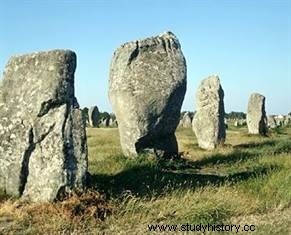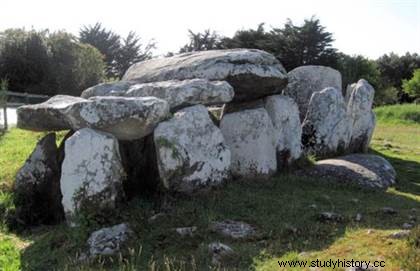 The Carnac alignments count several thousands of megalithic monuments, menhirs, dolmens and tumuli, dating from the Neolithic and the beginning of the Bronze Age. Located in Morbihan, Carnac means "the place where there are mounds of stones". It is a fascinating place, both for the beauty of the buildings and for the unresolved mystery of the presence of the menhirs, dolmens and cromlechs erected by man between 5000 and 3000 BC. It is considered that these alignments would have been designed according to the sunrises and sunsets of the Sun at the winter and summer solstices.
The Carnac alignments count several thousands of megalithic monuments, menhirs, dolmens and tumuli, dating from the Neolithic and the beginning of the Bronze Age. Located in Morbihan, Carnac means "the place where there are mounds of stones". It is a fascinating place, both for the beauty of the buildings and for the unresolved mystery of the presence of the menhirs, dolmens and cromlechs erected by man between 5000 and 3000 BC. It is considered that these alignments would have been designed according to the sunrises and sunsets of the Sun at the winter and summer solstices.
Carnac, a set of standing stones
The men of that time already lived in very elaborate societies and the large stone monuments (megaliths) they built served as places of prayer. These sites are mainly located on the western European seaboard as well as in England and Ireland. In France, most of these dolmens and menhirs are found in Brittany, but they are also found inland, such as in Bougon, in Deux-Sèvres, in Saint-Sernin-sur Rance, in the Aveyron (sculpted menhir), or even in Corsica; some graves are richly decorated with figurative or abstract motifs (Gavrinis, in Morbihan).
 These stones are scattered by the thousands all over Brittany. Some, erect and isolated, are called “menhirs”. Associated with others, they form an enclosure called "cromlech". The dolmen is composed of pillars which support a very heavy stone. The function is mainly funerary. Other stones are drawn up in parallel lines, they then form the “alignments”. In Carnac, about 2730 menhirs extend over an area of 4 km2. During the installation, around 3000 BC. AD, there must have been more than 10,000 over an area of 8 km2. There are three major series of menhirs in Carnac:the alignment of Ménec and those of Kermario and Kerlescan.
These stones are scattered by the thousands all over Brittany. Some, erect and isolated, are called “menhirs”. Associated with others, they form an enclosure called "cromlech". The dolmen is composed of pillars which support a very heavy stone. The function is mainly funerary. Other stones are drawn up in parallel lines, they then form the “alignments”. In Carnac, about 2730 menhirs extend over an area of 4 km2. During the installation, around 3000 BC. AD, there must have been more than 10,000 over an area of 8 km2. There are three major series of menhirs in Carnac:the alignment of Ménec and those of Kermario and Kerlescan.
Menec's alignment
The alignment of Ménec is the most important site of Carnac. It has 1,050 menhirs, generally 3 m high, aligned in eleven lines and 100 m wide and 950 m long. Only one of them measures almost 4 m and is located in the middle of other smaller ones:it is the giant of Ménec, Its installation was probably carried out before the other stones. At the ends of the alignment are two cromlechs. The one established to the west is made up of seventy menhirs, most of which were raised during restoration. Unusually, houses have settled in the middle of the enclosure. On the other side of the alignment, there is another cromlech, almost completely demolished:only twenty-five standing stones remain.
These monuments may have celebrated the cult of the dead or that of the Sun, but their origin and meaning still remain very obscure. Some associate them with druidism, a thesis devoid of any foundation, because the last megaliths were built more than a thousand years before the appearance of the Celtic society which practiced this religion. The Bossenno, about 2 km east of Carnac, is the site of many burial mounds, it also houses the ruins of a Gallo-Roman villa.
Kermario and Kerlescan alignments
Located 250 m from that of Ménec, the alignment of Kermario consists of a passage dolmen and ten lines of raised stones whose height varies between 60 cm and 6m. The set extends over approximately 1 km in length, comprises 980 stones and included a cromlech which has now disappeared. A 3 m high menhir dominates the others. During a survey in 1977, James Miln discovered there, among other things, the remains of a Roman settlement, a polished axe, burnt stones and shards of pottery. The site also includes the artificial pond of Kerloquet as well as the quadrilateral and the giant of Manio 6.50 m high, the largest menhir in the region, it was damaged during its recovery at the beginning of the 20th century.
 The Kerlescan alignment is the smallest, but also the best preserved. It has 594 menhirs which extend over thirteen rows of 350 m long and 140 wide. To the west, a quadrangular cromlech is made up of 39 menhirs. A 98 m long tumulus, located to the north of this set, is the largest in the region. 200 m from the alignment, there is a dolmen with a side entrance.
The Kerlescan alignment is the smallest, but also the best preserved. It has 594 menhirs which extend over thirteen rows of 350 m long and 140 wide. To the west, a quadrangular cromlech is made up of 39 menhirs. A 98 m long tumulus, located to the north of this set, is the largest in the region. 200 m from the alignment, there is a dolmen with a side entrance.
Myths and Functions of Carnac
No one can tell what these sites were for. The main myth of the existence of these stones is that of Saint Cornely. Pursued by the Roman army, he finds himself stuck facing the sea. To save himself, he turns the Romans into stone. Hence the alignments. The possibility of upheaval resulting from a deluge has also been raised. Others think it is an aid for astronomy.
These alignments are oriented according to the sunrises during the equinoxes and solstices. This original calendar also presents the stages of agricultural life such as sowing, plowing and harvesting. Still others believe that they are sites dedicated to druidic worship and delimited by stones. Finally, the hypothesis of a snake cult has also been put forward because of the sinuosity of the alignments.
To go further
- The alignments of Carnac:Neolithic temples, by Jean-Pierre Mohen. Heritage Editions, 2000.
- Dolmens and menhirs:The megalithic civilization, by Jean Markale. Payot, 1994.
